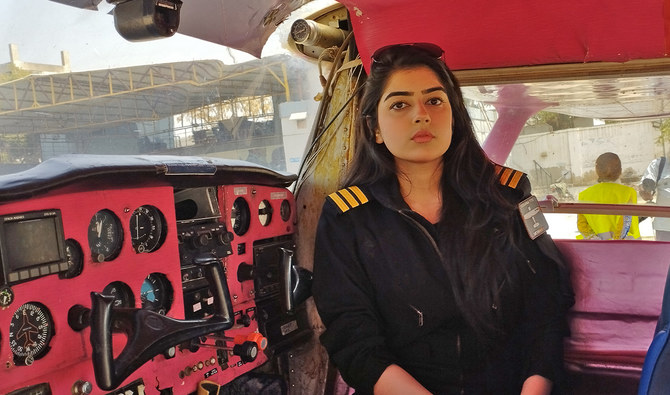KARACHI: For Azka Malik, 23, becoming a commercial pilot was a dream, but many people told her that it was not a woman’s job. Malik spent four years pursuing her dream at Karachi’s Sky Wing aviation academy and is now a woman commercial pilot, who aims to narrow the gender gap in Pakistan’s aviation industry.
The global aviation industry is predominated by men and women make up around 7 percent of the overall commercial pilots, according to Women in Aviation International, an American organization that provides networking, education, mentoring in the aviation and aerospace industries. But Pakistani aviation professionals say the number, though not exactly known, is lower in the South Asian country.
Malik, who recently graduated from the aviation academy, was glad at more women joining the industry and said she was ready to face the “big challenge” as aviation, like most sectors in Pakistan, was considered only men’s territory
“There are a lot more women who are joining this field now, so things are progressing, things are getting better and obviously our seniors have paved the way for us,” Malik told Arab News, sitting inside the cockpit of Cessna aircraft at her academy in Karachi on Tuesday.
“The freedom you feel when you’re in the aircraft, when you fly in the sky, it’s amazing. It’s like no other experience in this world.”
Apart from flying aircraft, Pakistani women are also at the forefront of technical and mechanical support for maintenance of aircraft.
Subhana Anwer, a 25-year-old aircraft maintenance technician, said the field requires a lot of study and hard work.
“If I speak from my heart about aviation, it takes a lot of work. It’s not easy. There’s a lot of studying to be done. There is a lot of late-night work. There is hardship... and, you know, honestly, it takes a lot of grit and how much you’re willing to put in,” Anwer said.
“Being a female, being a male either, it’s not really that much for the difference of dynamics. Being an aviation maintenance as a career, it takes a lot of studying, it takes a lot of hard work.”
Komal Khalid, another aircraft maintenance technician, said women had proven it wrong that aircraft maintenance was only men’s job as women professionals were increasingly seen in the field.
“It is said here that maintenance is only males’ job... it is not like this I think there is no work in the world that only man can do and woman can’t... this thinking is getting obsolete,” Khalid, 25, said.
“Definitely it is a tough field but it is not that women can’t do. We are present and are doing at front of you.”

Aircraft technicians are inspecting a Cessna flight training aircraft in Karachi, Pakistan, on March 7, 2023. (AN Photo)
A few years ago, there used to be around 15 aviation academies in Pakistan, but only nine of them are operational today.
Since its inception in 2019, the Sky Wing aviation academy has trained 25 pilots and 42 aircraft engineers and technicians. Of them, there are seven women pilots and 22 engineers and technicians.
Imran Aslam Khan, CEO of the Sky Wings academy, said the workforce trained by them was successfully contributing to the national and international aviation industries.
“We have trained several women pilots, engineers and technicians in aviation industry and now they are successfully working in different airlines within Pakistan and abroad,” Khan told Arab News.
“We believe that till the time we bring in women in all the industries, no country can progress because, it is half of the population of the world. So it goes in the same way for Pakistan that we have to involve the women so that they can contribute in the economy of the country.”
Pakistani aviation stakeholders say the industry is open to women and they are progressing at all fronts and can thrive with policy support.















